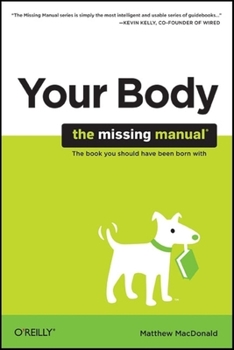Your Body: The Missing Manual
Select Format
Select Condition 
Book Overview
This full-color, visually rich guide answers these questions and more. Matthew MacDonald, noted author of Your Brain: The Missing Manual, takes you on a fascinating tour of your body from the outside in, beginning with your skin and progressing to your vital organs. You'll look at the quirks, curiosities, and shortcomings we've all learned to live with, and pick up just enough biology to understand how your body works. You'll learn:
That you shed skin more frequently than snakes do Why the number of fat cells you have rarely changes, no matter how much you diet or exercise -- they simply get bigger or smaller How you can measure and control fat That your hair is made from the same stuff as horses' hooves That you use only a small amount of the oxygen you inhale Why blood pressure is a more important health measure than heart rate -- with four ways to lower dangerously high blood pressure Why our bodies crave foods that make us fat How to use heart rate to shape an optimal workout session -- one that's neither too easy nor too strenuous Why a tongue with just half a dozen taste buds can identify thousands of flavors Why bacteria in your gut outnumbers cells in your body -- and what function they serve Why we age, and why we can't turn back the clock What happens to your body in the minutes after you die
Rather than dumbed-down self-help or dense medical text, Your Body: The Missing Manual is entertaining and packed with information you can use. It's a book that may well change your life.
Reader comments for Your Brain: The Missing Manual, also by author Matthew MacDonald:
"Popular books on the brain are often minefields of attractive but inaccurate information. This one manages to avoid most of the hype and easy faulty generalizations while providing easy to read and digest information about the brain. It has useful tricks without the breathless hype of many popular books." -- Elizabeth Zwicky, The Usenix Magazine
"...a unique guide that should be sought after by any who want to maximize what they can accomplish with their mental abilities and resources." -- James A. Cox, The Midwest Book Review - Wisconsin Bookwatch
"If you can't figure out how to use your brain after reading this guide, you may want to return your brain for another." -- The Sacramento Book Review, Volume 1, Issue 2, Page 19
"It's rare to find a book on any technical subject that is as well written and readable as Your Brain: The Missing Manual. The book covers pretty much anything you may want to know about your brain, from what makes it up, through how it develops to how to mitigate the affects of aging. The book is easy reading, fact packed and highlighted notes and practical applications. So if you want to learn more about your brain, how it works, how to get the best out of it or just want to stave off the ravages of Alzheimers (see chapter ten for details of how learning helps maintain your brain) then I can't recommend this book highly enough." -- Neil Davis, Amazon.co.uk
"MacDonald's writing style is perfect for this kind of guide. It remains educational without becoming overly technical or using unexplained jargon. And even though the book covers a broad scope of topics, MacDonald keeps it well organized and easy to follow. The book captures your attention with fun facts and interesting studies that any person could apply to their own understanding of human ability. It has great descriptions of the brain and its interconnected parts, as well as providing full color pictures and diagrams to offer a better explanation of what the author is talking about." -- Janica Unruh, Blogcritics Magazine





